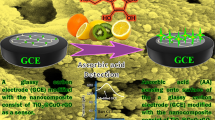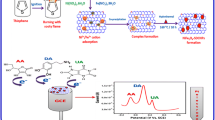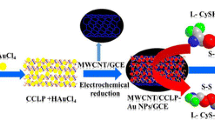Abstract
In this study, a solution-processing based galvanic deposition approach is described for in-situ deposition of gold nanoparticles (AuNP) on delaminated titanium Ti3C2Tx nanosheets under ultrasonication. The nanocomposite (AuNP@Ti3C2Tx) was placed on a glassy carbon electrode (GCE) and then applied to electrochemically with label-free, and simultaneously sense uric acid (UA), and folic acid (FA) at physiological pH. The modified GCE has attractive figures of merit: (i) The working potentials for UA and AA are well separated (+0.35 V and 0.70 V vs. Ag|AgCl); (ii) wide linear responses (from 0.03–1520 μM for UA and from 0.02–3580 μM for FA; (iii) good electrochemical sensitivities for both UA and FA (0.53 and 0.494 μAμM−1.cm−2, respectively), and (iv) detection limits of 11.5 nM (UA) and 6.20 nM (FA). The electrode exhibited good repeatability (RSD = 4.4%), acceptable reproducibility (RSD = 4.1%), and excellent stability (91.8% over one-month storage). The method was applied to analyze spiked serum samples, and modified GCE is shown appreciable recoveries (97.1–98.8% and 96.8–98.0% for UA, and FA, respectively).

A photograph (top left) of colloidal suspension of gold nanoparticles (AuNPs). They were grown on the delaminated titanium carbide Ti3C2Tx MXene nanosheet via galvanic displacement deposition method, and their corresponding a low-resolution transmission electron microscopy micrograph (top right) of AuNP@Ti3C2Tx. The graphical representation of AuNP@Ti3C2Tx drop-casted on glassy carbon electrode (GCE) (bottom left), and their voltammetric measurement were applied in the presence of both uric acid and folic acid with increasing the concentration of both analytes (bottom right).




Similar content being viewed by others
References
Sharaf El Din UAA, Salem MM, Abdulazim DO (2017) Uric acid in the pathogenesis of metabolic, renal, and cardiovascular diseases: a review. J Adv Res 8:537–548
Gao Y, Sheng C, Xie RH, Sun W, Asztalos E, Moddemann D (2016) New perspective on impact of folic acid supplementation during pregnancy on neurodevelopment/autism in the offspring children - a systematic review. PLoS One 11:e0165626
Lakshmi D, Whitcombe MJ, Davis F, Sharma PS, Prasad BB (2011) Electrochemical detection of uric acid in mixed and clinical samples: a review. Electroanalysis 23:305–320
Labib M, Sargent EH, Kelley SO (2016) Electrochemical methods for the analysis of clinically relevant biomolecules. Chem Rev 116:9001–9090
Batchelor-McAuley C, Katelhon E, Barnes EO, Compton RG, Laborda E, Molina A (2015) Recent advances in voltammetry. ChemistryOpen 4:224–260
Zhu C, Yang G, Li H, Du D, Lin Y (2015) Electrochemical sensors and biosensors based on nanomaterials and nanostructures. Anal Chem 87:230–249
Abdelwahab AA, Shim YB (2015) Simultaneous determination of ascorbic acid, dopamine, uric acid and folic acid based on activated graphene/MWCNT nanocomposite loaded au nanoclusters. Sens Actuators B-Chem 221:659–665
Cinková K, Švorc Ľ, Šatkovská P, Vojs M, Michniak P, Marton M (2015) Simple and rapid quantification of folic acid in pharmaceutical tablets using a cathodically pretreated highly boron-doped polycrystalline diamond electrode. Anal Lett 49:107–121
Kingsley MP, Desai PB, Srivastava AK (2015) Simultaneous electro-catalytic oxidative determination of ascorbic acid and folic acid using Fe3O4 nanoparticles modified carbon paste electrode. J Electroanal Chem 741:71–79
Chekin F, Teodorescu F, Coffinier Y, Pan GH, Barras A, Boukherroub R (2016) MoS2/reduced graphene oxide as active hybrid material for the electrochemical detection of folic acid in human serum. Biosens Bioelectron 85:807–813
Zhang D, Ouyang X, Ma W, Li L, Zhang Y (2016) Voltammetric determination of folic acid using adsorption of methylene blue onto electrodeposited of reduced graphene oxide film modified glassy carbon electrode. Electroanalysis 28:312–319
Tahernejad-Javazmi F, Shabani-Nooshabadi M, Karimi-Maleh H (2019) 3D reduced graphene oxide/FeNi3-ionic liquid nanocomposite modified sensor; an electrical synergic effect for development of tert-butylhydroquinone and folic acid sensor. Compos Part B-Eng 172:666–670
Naguib M, Kurtoglu M, Presser V, Lu J, Niu J, Heon M (2011) Two-dimensional nanocrystals produced by exfoliation of Ti3AlC2. Adv Mater 23:4248–4253
Naguib M, Mochalin VN, Barsoum MW, Gogotsi Y (2014) 25th anniversary article: MXenes: a new family of two-dimensional materials. Adv Mater 26:992–1005
Anasori B, Lukatskaya MR, Gogotsi Y (2017) 2D metal carbides and nitrides (MXenes) for energy storage. Nat Rev Mater 2:16098
Sinha A, Dhanjai ZH, Yujin H, Lu X, Chen J, Jain R (2018) MXene: an emerging material for sensing and biosensing. Trends Anal Chem 105:424–435
Anasori B, Gogotsi Y (2019) 2D Metal Carbides and Nitrides (MXenes). Springer International Publishing, Switzerland AG
Rasool K, Pandey RP, Rasheed PA, Buczek S, Gogotsi Y, Mahmoud KA (2019) Mater today https://doi.org/10.1016/j.mattod.2019.05.017
Satheeshkumar E, Makaryan T, Melikyan A, Minassian H, Gogotsi Y, Yoshimura M (2016) One-step solution processing of Ag, au and Pd@MXene hybrids for SERS. Sci Rep 6:32049
Sarycheva A, Makaryan T, Maleski K, Satheeshkumar E, Melikyan A, Minassian H, Gogotsi Y, Yoshimura M (2017) Two-dimensional titanium carbide (MXene) as surface-enhanced Raman scattering substrate. J Phys Chem C 121:19983–19988
Kumar S, Gandhi KS, Kumar R (2007) Modeling of formation of gold nanoparticles by citrate method. Ind Eng Chem Res 46:3128–3136
Qian A, Seo JY, Shi H, Lee JY, Chung CH (2018) Surface functional groups and electrochemical behavior in dimethyl sulfoxide-delaminated Ti3C2Tx MXene. ChemSusChem 11:3719–3723
Zhang CJ, Pinilla S, McEvoy N, Cullen CP, Anasori B, Long E, Park SH, Seral-Ascaso A, Shmeliov A, Krishnan D, Morant C, Liu X, Duesberg GS, Gogotsi Y, Nicolosi V (2017) Oxidation stability of colloidal two-dimensional titanium carbides (MXenes). Chem Mater 29:4848–4856
Pan X, Xu YJ (2013) Fast and spontaneous reduction of gold ions over oxygen-vacancy-rich TiO2: a novel strategy to design defect-based composite photocatalyst. Appl Catal A 459:34–40
Porter LA, Choi HC, Ribbe AE, Buriak JM (2002) Controlled electroless deposition of noble metal nanoparticle films on germanium surfaces. Nano Lett 2:1067–1071
Ensafi AA, Karimi-Maleh H (2010) Modified multiwall carbon nanotubes paste electrode as a sensor for simultaneous determination of 6-thioguanine and folic acid using ferrocenedicarboxylic acid as a mediator. J Electroanal Chem 640:75–83
Jothi L, Neogi S, Jaganathan SK, Nageswaran G (2018) Simultaneous determination of ascorbic acid, dopamine and uric acid by a novel electrochemical sensor based on N2/Ar RF plasma assisted graphene nanosheets/graphene nanoribbons. Biosens Bioelectron 105:236–242
Yang L, Liu D, Huang J, You T (2014) Simultaneous determination of dopamine, ascorbic acid and uric acid at electrochemically reduced graphene oxide modified electrode. Sens Actuators B-Chem 193:166–172
Lian Q, He Z, He Q, Luo A, Yan K, Zhang D (2014) Simultaneous determination of ascorbic acid, dopamine and uric acid based on tryptophan functionalized graphene. Anal Chim Acta 823:32–39
Ping J, Wu J, Wang Y, Ying Y (2012) Simultaneous determination of ascorbic acid, dopamine and uric acid using high-performance screen-printed graphene electrode. Biosens Bioelectron 34:70–76
Sheng ZH, Zheng XQ, Xu JY, Bao WJ, Wang FB, Xia XH (2012) Electrochemical sensor based on nitrogen doped graphene: simultaneous determination of ascorbic acid, dopamine and uric acid. Biosens Bioelectron 34:125–131
Asif M, Aziz A, Wang H, Wang Z, Wang W, Ajmal M, Xiao F, Chen X, Liu H (2019) Superlattice stacking by hybridizing layered double hydroxide nanosheets with layers of reduced graphene oxide for electrochemical simultaneous determination of dopamine, uric acid and ascorbic acid. Microchim Acta 186:61
Baccarin M, Rowley-Neale SJ, Cavalheiro ÉTG, Smith GC, Bank CE (2019) Nanodiamond based surface modified screen-printed electrodes for the simultaneous voltammetric determination of dopamine and uric acid. Microchim Acta 186:200
Zhang L, Li S, Xin J, Ma H, Pang H, Tan L, Wang X (2019) A non-enzymatic voltammetric xanthine sensor based on the use of platinum nanoparticles loaded with a metal-organic framework of type MIL-101(Cr). Application to simultaneous detection of dopamine, uric acid, xanthine and hypoxanthine. Microchim Acta 186:9
Zhao Y, Zhou J, Jia Z, Huo D, Liu Q, Zhong D, Hu Y, Yang M, Bian M, Hou C (2019) In-situ growth of gold nanoparticles on a 3D-network consisting of a MoS2/rGO nanocomposite for simultaneous voltammetric determination of ascorbic acid, dopamine and uric acid. Microchim Acta 186:92
Acknowledgements
The authors would like to thank Professor Dr. Yury Gogotsi for the pristine MAX phase of Ti3AlC2 and MXene-Ti3C2Tx samples (MXene samples were prepared by Dr. Olha Mashtalir at Drexel University) from the Drexel University, PA, USA (https://nano.materials.drexel.edu/). Also, the authors are grateful to Dr. Chia-Ying Su and Mr. Bo-Yong Wu for their help in this research project. And we thank to Dr. M. P. Karthikayini for the valuable comments on this manuscript. Dr. Satheeshkumar Elumalai acknowledges support from National Cheng Kung University (grant No. HUA 103-3-3-158 under “Aim for Top University Project (ATUP)” as ATUP Postdoctoral Fellowship) Taiwan.
Author information
Authors and Affiliations
Corresponding authors
Ethics declarations
Competing financial interests
The authors declare no competing financial interests.
Additional information
Publisher’s note
Springer Nature remains neutral with regard to jurisdictional claims in published maps and institutional affiliations.
Electronic supplementary material
ESM 1
(DOCX 396 kb)
Rights and permissions
About this article
Cite this article
Elumalai, S., Mani, V., Jeromiyas, N. et al. A composite film prepared from titanium carbide Ti3C2Tx (MXene) and gold nanoparticles for voltammetric determination of uric acid and folic acid. Microchim Acta 187, 33 (2020). https://doi.org/10.1007/s00604-019-4018-0
Received:
Accepted:
Published:
DOI: https://doi.org/10.1007/s00604-019-4018-0




